Udaipur
The city of Dawn,Udaipur is a lovely land around the azure water lake, hemmed in by the lush hills of the Aravallis. A vision in white drenched in romance and beauty, Udaipur is a fascinating blend of sights, sound and experiences and inspiration for the imagination of poets,painters and writers.
Its kaleidoscope of fairy-tale palaces,lakes,temples,gardens and narrow lanes strewn with stalls,carry the flavor of a heroic past,epitomizing valour and chivalry. Their reflection in the placid waters of the Lake Pichhola is an enticing sight.
Udiapur is the jewel of Mewar-a kingdom ruled by the Sisodia dynasty for 1200 Years. The foundation of the city has an interesting legend associated with it. According to it, Maharana Udai Singh, the founder,was hunting one day when he met a holy man meditations on a hill overlooking the Lake Pichhola.
The hermit blessed the Maharana and advised him to build a palace at this favorable located spot with a fertile valley watered by the stream, a lake,an agreeable altitude and an ampitheatre of low mountains. Maharana followed the advise of the hermit and founded the city in 1559 A.D.
Overlooking the aquamarine expanses of the Lake Pichhola stands the splendid City Palace-a marvel in granite and marble of the original eleven gates of the Udaipur City,only five remain. The Suraj Pol the original or Sun Gate on the eastern side is the main entrance to the city.
Exquisite lake palaces of Udaipur shimmering like jewels on Lake Pichhola are overwhelming in splendor.
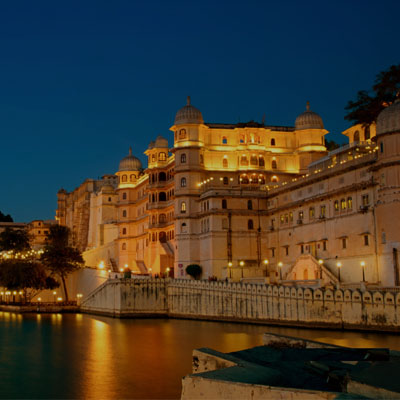
Several places of interest around Udaipur, including the majestic, Chittaurgarh,the mountain fortress of Kumbhalgarh, beautiful jain temple of Ranakpur,Ekligji and Nathdwara and the cool retreat of Mt. Abu, make the visit to Udaipur a memorable one.
The Mewar Festival is celebrated to welcome the advent of spring. It coincides with the festival of Gangaur (March - April). The festival of Gangaur is very important for the women of Rajasthan. This is the time they get to dress up and really enjoy themselves. Ceremonial processions (usually all female) with the regular bride-n-groom theme, complete with brass band, Images of deities (Isar and Gangaur), horses etc., throng through the different parts of the city. The procession leisurely winds it's way to the Gangaur Ghat at Lake Pichola. Here, the images are transferred to special boats amidst much singing and festivity. The day then culminates with cultural programs and fireworks display.

City Palaces: A majestic architectural marvel towering over the lake on a hill surrounded by crenallated walls, it is a conglomeration of courtyards,pavilions,terraces,corridors,rooms and hanging gardens. The main entrance is through the triple arched gate, the ‘Tripolia’with eight marble porticos. The Maharana were weighed under the gate in the gold,the equivalent amount of which was distributed among the populace.
The Suraj Gokhada, the balcony of the sun, is where the Suryavanshi Maharanas of Mewar presented themselves to the people in time of trouble to restore their confidence. The ‘Mor Chowk’ known for its exquisite peacock mosaics in glass and the ‘Chini Chitrashala’noted for its blue and white ceramics are other attractions in the palace.
Jagdish Temple: Built in 1651 A.D. By Maharana Jagat Singh, this Indo-Aryan temple is the largest and the most beautiful temple of Udaipur with noteworthy sculpted images.
Bharatiya Lok Kala Mandir: The interesting collection exhibited by this Indian folk arts museum includes folk dresses,ornaments,puppets,masks,dolls,folk musical instruments, folk deities and paintings.
Saheliyon-ki-Bari (Garden of the maids of Honour): This small ornamental garden was a popular relaxing spot where royal ladies came for a stroll and hence the name. The garden has many fountains in its four delightful pools,chiseled kiosks and marble elephants.
Pratap Memorial : Atop the Moti Magri or pearl hill,overlooking the Fateh Sagar Lake is the memorial of the Rajput hero Maharana Pratap with a bronze statue of the Maharana.
Fateh Sagar: A beautiful lake,overlooked by a number of hills on the three sides and the Pratap Memorial on the north was built by Maharana Fateh Singh. In the middle of the lake is Nehru Park-a lovely garden island with a boat shaped café accessible by an enjoyable boat ride.
Pichhola Lake: The picturesque lake that entranced Maharaja Udai Singh. It was later enlarged by the founder. The lake is surrounded by hills, palaces,temples, bathing ghats and embankments. Two island palaces,Jag Mandir and Jag Niwas(Lake Palace) on the lake are of breathtaking magnificence.
Ahar: The ancient capital of Sisodias, 3 km from Udaipur,Ahar boasts of a profusion of royal cenotaphs of the rulers of Mewar. A rare collection of antiquities including earthen pots, iron objects and other art items excavated in the region are displayed in a small Govt. museum.
Sajjan Garh: Dominating the city’s skyline is the monsoon palace of Sajjangarh.It offers a panoramic overview of the city’s lakes,palaces and the surrounding countryside.
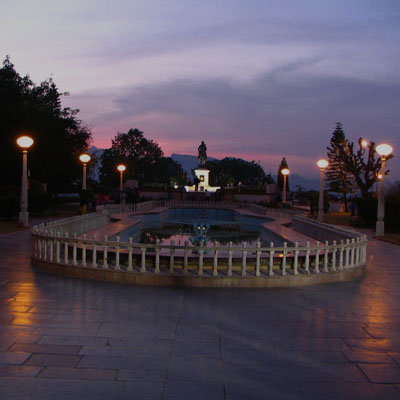
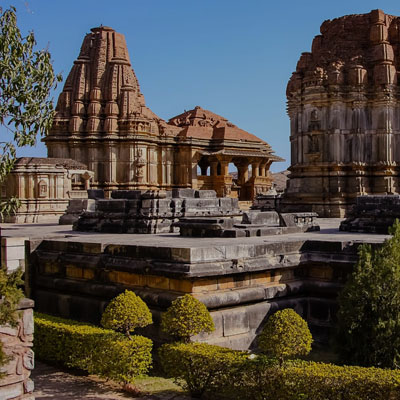
Gulab Bagh: A spectacular rose garden laid out by Maharana Sajjan Singh. A library in the garden has a rare collection of ancient handwritten manuscripts and books.
NAGDA: Nagda (anc. Naaghrida) was the old capital of Mewar. The chief relic, now extinct consists of the twin 'Saas - Bahu' temple of the 10th century. Spartan sanctums are here, wedded to sumptuous Mandaps, that of the bigger temple being more so. This latter in a closed one, richly carved both inside and outside, as compared to the open one in the other case. The group faces a large tank, the route to which is marked by a handsome torana or ceremonial gate.
EKLINGJI : The princes of Mewar considered themselves as ruling on behalf of Eklingji (Mahadeva) enshrined in an imposing temple in the neighboring Kailashpuri. Despite the recent glitz, the palace has an atmosphere. The complex has many other temples, including the very austere Lakulish of the 10th century with an imposing black statue of the defied Shaivite preacher of 2nd century A.D.
CHAWAND : From Jaisamand, one can go on to Chawand. After the reverse suffered at Haldighati, Maharana Pratap took to the jungles and a guerilla mode of warfare. It was during this phase that Pratap acquired Chawand and made it his capital in 1585. It has been noted that the architecture at Chawand reflects a spartan defence - consciousness.
NATHDWARA : When Auranagzeb embarked on a policy of wholesale destruction of Hindu temples, the custodians of the idol of Shrinathji of Govardhan, near Mathura, left that place with the idol in search of a new haven. While several other princes were diffident, it was Maharana Rajsingh of Mewar who dared to provide refuge. In 1672 Shrinathji was installed in a new temple built in village Sihad, now called Nathdwara, on the banks of the Banas. Ever since, Nathdwara is a place of great sanctity for the Vaishnavas of Pushtimargi or Vallabha sect. Among other things, Nathdwara is known for its Pichhwais (large painting on cloth depicting legends from the life of Lord Krishna) and Haveli music (devotional music, akin to Dhrupad - singing, with compositions meant for various seasons, festivals and sections of the day).
JAISAMAND LAKE : A stunningly situated artificial lake, built in the 17th century A.D. by Maharana Jai Singh is the second largest in Asia. Maharana Jai Singh at the time of foundation celebrated the occasion by giving away gold in charity after a Tuladaan ceremony. In the lake there are three islands whose inhabitants use Bhels (boats) to reach the shore. On the top of two nearby hillocks are two old palaces constructed by Maharana Jai Singh. A very fine view of the lake is available from these palaces. Graceful marble chhatris flank the embankment and beautiful summer palaces of the Udaipur queens. Jaisamand Island Resort is also worth visiting.
A trip to Jaisamand Wildlife Sanctuary allows a close encounter with the rich wildlife in their natural habitat.
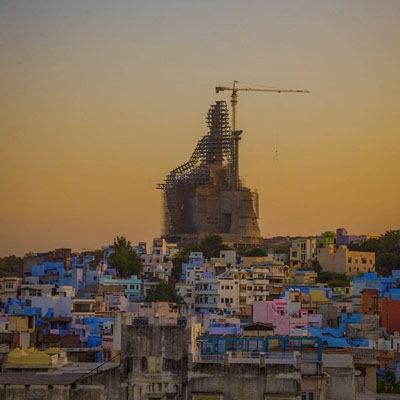
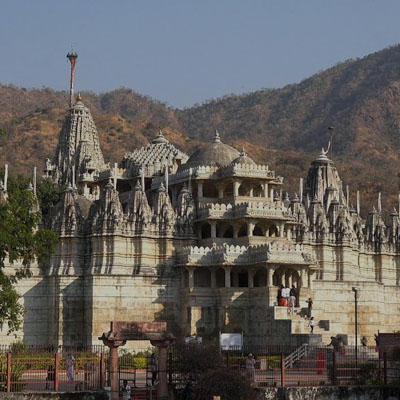
RANAKPUR : Renowned for some marvelously carved Jain temples in amber stones, Ranakpur is one of the five holy places of the Jain community. These temples were created in the 15th century A.D. during the reign of Rana Kumbha and are enclosed within a wall. The central 'Chaumukha' or four faced temple is dedicated to the venerated Tirthankara Rishabhji. Open on all four sides, it enshrines the four faced image of Adinath. Sprawling over 48,000 sq.feet, the temple is an astounding creation with 29 halls and 1,444 pillars - all distinctly carved.
Images of 24 tirthankaras are carved on the 'Mandaps' or porticoes in a corridor around the shrine with each mandap having a 'Shikhar' or spire adorned with little bells on the top. The gentle breeze wafting through the corridors move the bells creating celestial music all around the complex. Rising in three stories, the temple has four small shrines with 80 spires supported by 420 columns.
Two temples, dedicated to the Jain saints - Parsvanath and Neminath, face the main temple. The temples have beautiful carvings similar to that of Khajuraho. Another temple worth visiting is the nearby Sun Temple, an 8th century A.D. temple dedicated to the Sun god. The temple has polygonal walls, richly embellised with carvings of warriors, horses and solar detties riding splendid chariots.
KUMBHALGARH : Cradled in the cluster of thirteen mountain peaks of the Aravali ranges, the formidable medieval citadel - Kumbhalgarh stands a wary sentinel to the past glory. Rising from a prominent ridge, 1914 meters high from the sea level, the fort was built in 15th century A.D. by Maharana Kumbha and is the principal fortification after Chittaurgarh, lying 90 Km north-west of Udaipur.
The massive fort, encompassed by a 36 Km long wall, has seven majestic gates and seven ramparts, one within the other. Rounded bastions and soaring watch towers strengthen the crenellated walls of the fort making it an impregnable structure.
Fascinating chambers are built on the western side of the last gate - the 'Nimboo Pol'. According to history, the infant Udai Singh was smuggled from Bundi and hidden in these chambers by his faithful maid Panna Dai to save him from the murderous intensions of his Uncles who desired the throne.
Udai Singh ascended the throne of Mewar with Kumbhalgarh as his residence and later established Udaipur - the beautiful lake city.
Within the fort are many magnificent palaces and an array of ruined temples. The most picturesque of the palaces is the 'Badal Mahal' or the palace of the cloud. The palace has got its name for being the highest of all the structures. It offers a superb bird's eye view of the countryside surrounding the fort as well as of other ruins within the fort.
The ancient ruins of the temples within the fort date back to the Mauryan period built during the reign of the grandson of the Mauryan Emperor Ashoka who belonged to the Jain community.
Most of the ruins in Kumbhalgarh are of the Jain temples of various periods.
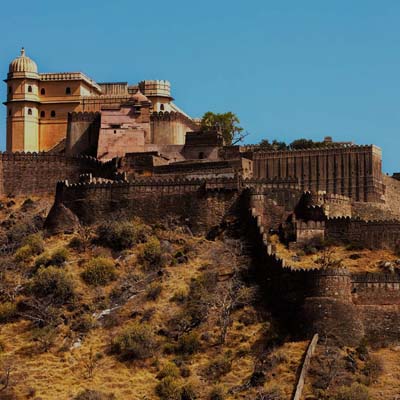
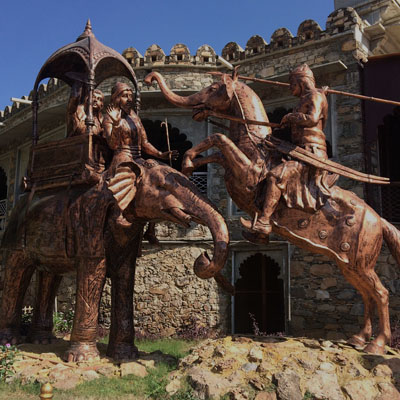
HALDIGHATI: When Rana Pratap refused to show subservience, Akbar decided to chastise him and sent a big army, under Man Singh of Amer, for the purpose. On the 31st of May, 1576, the two armies - 'which were friendly to war and inmicial to life and which treated life as cheap and honour dear' - took positions in Haldighati, ' the turmeric - coloured vale', near Khamnor. The initial assault of the Mewaris rattled up the imperial forces but were then routed. Pratap was saved by Shakti Singh, his estranged brother, but Pratap's famous steed, Chetak, succumbed to his injuries.
Haldighati is now very much on the tourist map and can be covered in a round trip covering Nagda, Eklingji, Delwara, Nathdwara, Rajsamand and Molela.
KANKROLI AND RAJNAGAR : Nathdwara is 48 kms to the north of Udaipur. A few kilometers further on, are located the twin towns of Kankroli and Rajsamand, the latter now the headquarters of a District. As with the Shrinathji at Nathdwara, the idol of Dwarkadheeshji was installed in a new temple at Kankroli. Both the towns nestle by the beautiful lake of Rajsamand which was got built by Maharana Raj Singh, perhaps, as a famine - relief work, during 1662 -76, with a work force of 60,000 and at a cost of Rs. 1.05 crore. The lake, now measures 1.5 miles, by 2.75 miles and has a catchment area of about 195 sq.miles. The chief glory of the lake lies in the elaborate main dam called "Nauchowki" (nine pavilions) after the nine cupolas - inspired, perhaps, by the flat-roofed marble 'baradaris' built by Shahjehan on the dam of the Anasagar Lake at Ajmer - which adorn it.
